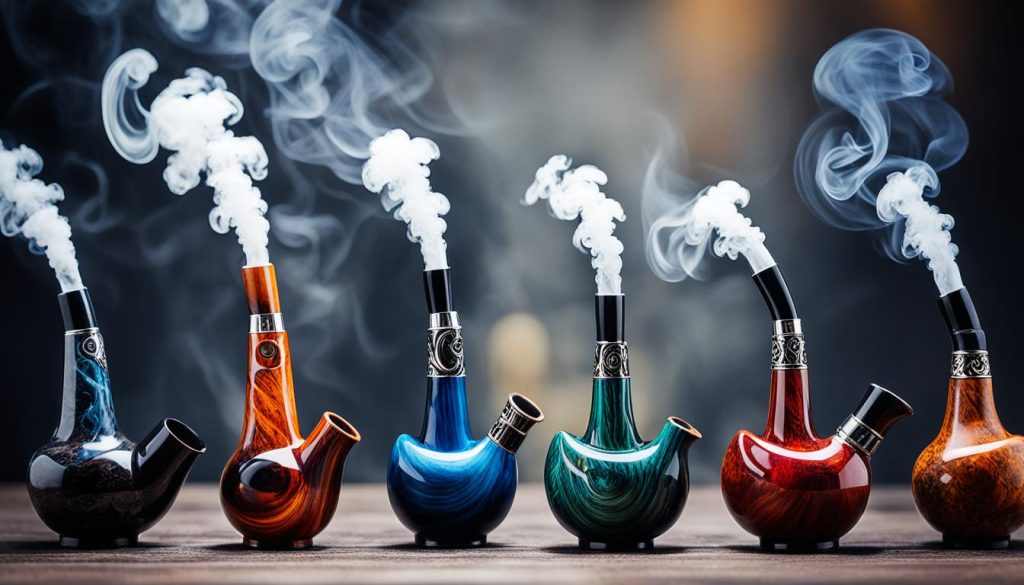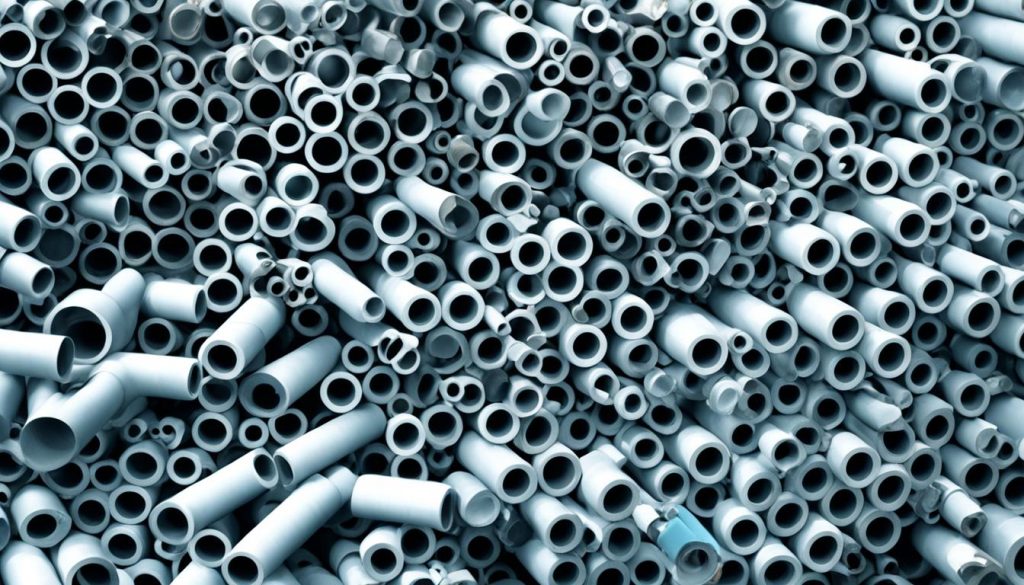DIY Guide: How to Make a Pipe Efficiently
Did you know that DIY pipe making is gaining popularity as a creative and cost-effective way to enjoy smoking? More and more people are discovering the satisfaction of crafting their own customized pipes, tailored to their preferences and style. Whether you’re a seasoned smoker looking for a new smoking device or a beginner curious about the process, this DIY guide on how to make a pipe will provide you with step-by-step instructions and valuable tips to help you create a pipe that is unique to you.
Key Takeaways:
- DIY pipe making is a growing trend, allowing smokers to create personalized and unique smoking devices.
- This DIY guide provides step-by-step instructions for making your own pipe.
- Using safe materials and following recommended practices is crucial for a safer smoking experience.
- Personalizing your pipe can enhance the enjoyment and prevent confusion when sharing with others.
- Explore different types of smoking pipes and choose the one that suits your preferences and smoking style.
Common Household Items to Make a Pipe
When it comes to DIY pipe making, you’d be surprised to know that many common household items can be repurposed to create your own homemade pipe. Using everyday materials not only adds a unique touch to your smoking experience but also allows you to exercise your creativity. However, it is essential to ensure safety and choose the right materials to avoid any health risks.
Let’s take a look at some common household items that can be transformed into functional pipes:
- Aluminum cans and foil: While aluminum cans and foil are often used to construct makeshift pipes, it’s crucial to note that they can release harmful vapors when heated. These vapors can be dangerous if inhaled, posing a risk to your health. It is advisable to avoid using aluminum cans or foil to make a pipe.
- Bic pens: Bic pens are a popular choice for creating a quick and easy DIY pipe. By removing the ink cartridge and attaching a bowl to the tip, you can repurpose a pen into a portable smoking device. However, it’s important to ensure that the materials used for the bowl are safe and won’t release any harmful substances when heated.
- Fruits like apples: Fruits such as apples have been used for centuries as a natural and disposable pipe. With a bit of carving, you can transform an apple into a functional smoking device. Keep in mind that fruits like apples can only be used a few times before they become unusable.
- Ratchet nuts: Ratchet nuts, commonly found in toolboxes, can serve as a pipe bowl when attached to a tube. They can be easily found at hardware stores and provide a unique and creative option for crafting your own pipe.
- Water bottles: Plastic water bottles can be repurposed into simple water pipe setups. By creating a small hole in the bottom and attaching a tube or stem, you can create a basic water filtration system. It’s important to note that plastic may release harmful chemicals when exposed to heat, so use this DIY pipe sparingly and with caution.
Remember, choosing the right materials is crucial to ensure a safe smoking experience. While these household items offer creative alternatives, it’s important to prioritize your well-being and avoid any potential health hazards. Next, let’s explore the different types of smoking pipes available in the market and their unique features.
Different Types of Smoking Pipes
When it comes to smoking pipes, there are various options available, each with its own unique features and benefits. Whether you’re a seasoned smoker or just starting out, it’s important to understand the different types of pipes available in order to find one that suits your preferences and needs.
Bongs
Bongs are popular smoking devices that utilize water filtration to provide a smoother smoking experience. They come in a variety of shapes and sizes, and their main function is to cool and filter the smoke before you inhale it. Bongs are often made of glass and can be quite elaborate in their design.
Bubblers
Bubblers are a smaller version of bongs and are known for their portability. They combine the water filtration of a bong with the convenience of a hand pipe. Bubblers are a great option for those who want a smoother hit without the larger size of a bong.
Chillums
Chillums are straight, conical pipes that are often used by Rastafarians and Hindu priests during religious ceremonies. They are simple and compact, and they offer a direct smoking experience without any added filtration.
Dab Rigs
Dab rigs are specifically designed for smoking concentrated cannabis wax, also known as dabs. They feature a glass or quartz banger that is heated, and the wax is then applied to the hot surface to produce vapor. Dab rigs typically require a torch for heating.
Hand Pipes
Hand pipes are small and portable smoking devices that can easily fit in your hand. They come in a variety of materials, including glass, metal, and wood. Hand pipes are a popular choice for smokers who value convenience and simplicity.
Steamrollers
Steamrollers are long, cylindrical pipes that are designed to deliver larger hits. They have a carb hole on one end and a mouthpiece on the other. Steamrollers offer a direct and powerful smoking experience.
Water Pipes
Water pipes include classic hookahs and bongs. They use water filtration to provide a smoother smoking experience. Water pipes are a popular choice for social gatherings and are often considered a more traditional and cultural way of smoking.
By understanding the different types of smoking pipes available, you can choose the one that best suits your preferences and smoking style. Whether you prefer the smoothness of a bong or the portability of a hand pipe, there’s a smoking pipe out there that’s perfect for you.
Best Materials for Making a Pipe
When it comes to making a pipe, choosing the right materials is crucial for a satisfying smoking experience. The best pipe materials should be durable, easy to clean, nontoxic, and nonreactive. Additionally, using materials that do not affect the taste or effect of the weed is important. Here are some commonly used materials for pipes:
Wood Pipes
Wood pipes are known for their attractive appearance and customizability. They can be carved into unique designs and personalized according to your preferences. However, it’s worth noting that wood pipes tend to absorb the taste of previous smoke sessions over time, which can affect the flavor of your smoking sessions. Regular cleaning and maintenance are essential to keep wood pipes in optimal condition.
Glass Pipes
Glass pipes are popular among smokers for their transparency, allowing you to see the smoke as it travels through the pipe. In addition to their aesthetic appeal, glass pipes are also easy to clean, making them a convenient choice. They don’t absorb the taste of previous sessions, ensuring a cleaner and more enjoyable smoking experience. Glass pipes are available in various shapes, sizes, and designs, catering to different preferences.
Metal Pipes
Metal pipes, such as those made of stainless steel or aluminum, offer durability and longevity. They are less likely to break compared to other materials, making them a reliable choice for pipe-making. Metal pipes are also easy to clean and maintain, ensuring a hygienic smoking experience. Due to their nonporous nature, they do not absorb flavors or odors, preserving the taste and quality of your smoke.
| Material | Durability | Ease of Cleaning | Taste Absorption |
|---|---|---|---|
| Wood | Medium | Requires Regular Cleaning | Absorbs Taste over Time |
| Glass | High | Easy to Clean | Does Not Absorb Taste |
| Metal (Stainless Steel or Aluminum) | High | Easy to Clean | Does Not Absorb Taste |
Safer Smoking Practices for Crystal Meth
When it comes to smoking crystal meth, there are important practices to follow in order to reduce the risk of harm. By prioritizing harm reduction and adopting safer smoking practices, you can help protect yourself and minimize potential risks.
One key aspect of safer smoking is using new smoking supplies and avoiding the sharing of equipment. Crystal meth can be associated with the transmission of viruses and infections, so using fresh supplies each time is essential for reducing these risks. Additionally, it’s important to use smoking supplies that are specifically designed for crystal meth, such as a bowl pipe.
Cleaning surfaces and hands before handling supplies is another important precaution. Using alcohol swabs can help disinfect surfaces and minimize the potential for infections. By taking this simple step, you can create a cleaner and safer smoking environment.
When using a bowl pipe for crystal meth, attaching a mouthpiece can provide an extra layer of protection. This helps prevent burns and cuts to the mouth, which can occur due to the intense heat of smoking. By prioritizing safety and using a mouthpiece, you can reduce the risk of injuries.
Lastly, it’s crucial to heat the crystal meth slowly and inhale the vapor immediately. This practice helps minimize the risk of burns, as rapid heating can lead to accidental contact with hot surfaces. By taking it slow and being mindful of the temperature, you can ensure a safer smoking experience.
Important Information about Safer Crystal Meth Smoking
When it comes to smoking crystal meth, there are essential factors to consider for a safer experience. By utilizing harm reduction supplies and following best practices, you can minimize potential risks and enhance your well-being.
Using Safer Smoking Supplies
Using harm reduction supplies specifically designed for crystal meth smoking is crucial. These supplies are designed to prevent burns and other harm. They include materials that can withstand high temperatures without releasing toxic fumes. By using these supplies, you can mitigate the risk of injuries and ensure a safer smoking session.
Personal Smoking Supplies
It is important to use personal smoking supplies and replace them regularly instead of sharing with others. Sharing supplies increases the risk of infection transmission. By using your own supplies, you can protect yourself and others from potential harm.
Mixing Substances
Mixing crystal meth with other substances, especially opioids, can have severe consequences. It significantly increases the risk of heart attack, stroke, and overdose. It is essential to avoid mixing substances to protect your health and well-being.
Safer Sex
Practicing safer sex is crucial to reduce the risk of transmitting HIV and other infections. It is essential to use proper protection methods, such as condoms, and engage in open communication with your partner regarding sexual health and history. Prioritizing safer sex practices ensures a healthier and safer lifestyle.
Stimulant Overamping
Overamping, a state of excessive stimulation, can have serious health risks. It is important to be aware of the signs and symptoms, such as extreme restlessness, anxiety, and increased heart rate. If you experience overamping, seeking proper care and support is crucial to ensure your well-being.
Overdose Prevention
Preventing an overdose is of utmost importance. Utilize harm reduction resources and practices to reduce the risk. Using drugs with others and carrying naloxone, an overdose-reversing medication, are effective measures in preventing fatal overdoses. By taking these steps, you can protect yourself and others from overdose-related harm.
Resources and Support for Safer Substance Use
When it comes to practicing safer substance use, there are various resources available to provide support and guidance. These resources aim to promote harm reduction and educate individuals on safer practices. Whether you’re looking for educational videos, harm reduction toolkits, or local harm reduction programs, there are resources out there to help.
Educational Videos
Educational videos are a great way to learn about safer substance use practices. They cover a wide range of topics such as safe smoking techniques, harm reduction fundamentals, and responding to overdoses. By watching these videos, you can gain valuable knowledge and insights to make more informed choices regarding your substance use.
Harm Reduction Toolkits
Harm reduction toolkits are another valuable resource for individuals who want to prioritize their well-being while using substances. These toolkits typically include practical information, tips, and resources to reduce the potential risks associated with substance use. They may provide guidance on safer smoking practices, safe injection techniques, overdose prevention, and safer sex practices.
Harm Reduction Programs
Harm reduction programs play a crucial role in supporting individuals who want to practice safer substance use. These programs offer a range of services such as counseling, testing for sexually transmitted infections (STIs), distributing harm reduction supplies, and connecting individuals to local resources. They provide a safe and non-judgmental environment for individuals to access the support and information they need.
By engaging with harm reduction services, you can gain access to valuable resources, connect with knowledgeable professionals, and receive the support necessary to make safer choices.
Remember, practicing safer substance use is important for minimizing potential harms and promoting overall well-being. Take advantage of the resources available to you and prioritize your health.
| Resource | Description |
|---|---|
| Educational Videos | Online videos providing information and guidance on safer substance use practices. |
| Harm Reduction Toolkits | Comprehensive toolkits containing resources and strategies for harm reduction. |
| Harm Reduction Programs | Organizations offering various services and support for safer substance use. |
Conclusion
Crafting your own pipe can be a fun and creative DIY project, but it’s crucial to prioritize safety and harm reduction throughout the process. By using safe materials and following recommended practices for smoking, you can reduce potential risks and ensure a safer pipe-making experience. Remember, your health and well-being should always be the top priority when engaging in any drug-related activities.
When making your pipe, opt for durable and non-toxic materials such as glass or metal, which are safer alternatives to plastic bottles or cans. Additionally, accessing harm reduction resources can provide valuable information and support to further minimize potential risks.
Always remember to take precautions and make informed choices. Prioritizing harm reduction and pipe safety will not only protect your health, but also enhance your overall DIY pipe-making experience.
- Investing Wisely: How Windows & Doors in Boost Property Value and Financial Health - April 24, 2025
- The Financial Impact of Personal Injuries: Why Legal Help Matters for Business Owners - April 16, 2025
- The Hidden Financial Costs of Domestic Assault: What Business Owners Need to Know - April 16, 2025














